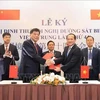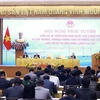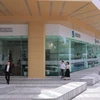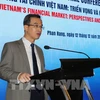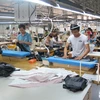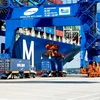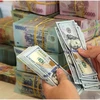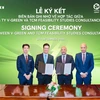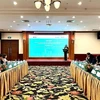The Vietnam Textile Group (Vinatex) will build a fiber-weaving-dying and garment complex in Que Son district in the central province of Quang Nam this year, costing 1.5 trillion VND (71 million USD).
Deputy General Director of the group, Tran Van Pho, said on January 13 that the complex was part of the Memorandum of Understanding (MoU) signed between Vinatex and the province two years ago.
"The complex is an intensive investment project in the central region, in preparation for the Trans-Pacific Partnership Agreement (TPP). It is built to provide material for boosting the textile and garment industry in Quang Nam, Da Nang and other neighbouring coastal central provinces," Pho said.
"The complex is expected to earn 1.7 trillion VND (81 million USD) in revenue per year in the first phase of construction, contributing 35 billion VND to the provincial budget and 2,000 jobs," he said.
He noted that the complex was designed to produce 4,600 tonnes of spindles, along with a production line of textile, knitwear, and dye manufacturing of 5,000 tonnes of products.
He added that a garment plant in the complex would produce 25 million products. Additionally, a waste water treatment plant would be built with a capacity of 5,000 cubic metres per day and night.
As scheduled, Vinatex would also begin construction of a fibre production plant in Thang Binh district and a garment plant in Nui Thanh district.
Also, Vice Chairman of the provincial people's committee Dinh Van Thu said 91 textile and garment companies operating in the province last year produced 2.9 trillion VND (138 million USD), which is 6.6 percent of the province's total industrial production value. The industry produced 55 million metres of cloth and created jobs for 3,000 labourers.
Thu also asked for the group's help, calling for more investment and co-operation from foreign partners in supportive industries for garment and textile industries in the province.
Further, Vinatex plans to develop a 500ha cotton farm in Dai Loc district in the coming years.
According to the Vietnam Textile and Apparel Association, Vietnam has 250 industrial parks nationwide, but only Nam Dinh, Hung Yen and Binh Thuan provinces reserve areas for developing the fiber-weaving-dying industry.-VNA
Deputy General Director of the group, Tran Van Pho, said on January 13 that the complex was part of the Memorandum of Understanding (MoU) signed between Vinatex and the province two years ago.
"The complex is an intensive investment project in the central region, in preparation for the Trans-Pacific Partnership Agreement (TPP). It is built to provide material for boosting the textile and garment industry in Quang Nam, Da Nang and other neighbouring coastal central provinces," Pho said.
"The complex is expected to earn 1.7 trillion VND (81 million USD) in revenue per year in the first phase of construction, contributing 35 billion VND to the provincial budget and 2,000 jobs," he said.
He noted that the complex was designed to produce 4,600 tonnes of spindles, along with a production line of textile, knitwear, and dye manufacturing of 5,000 tonnes of products.
He added that a garment plant in the complex would produce 25 million products. Additionally, a waste water treatment plant would be built with a capacity of 5,000 cubic metres per day and night.
As scheduled, Vinatex would also begin construction of a fibre production plant in Thang Binh district and a garment plant in Nui Thanh district.
Also, Vice Chairman of the provincial people's committee Dinh Van Thu said 91 textile and garment companies operating in the province last year produced 2.9 trillion VND (138 million USD), which is 6.6 percent of the province's total industrial production value. The industry produced 55 million metres of cloth and created jobs for 3,000 labourers.
Thu also asked for the group's help, calling for more investment and co-operation from foreign partners in supportive industries for garment and textile industries in the province.
Further, Vinatex plans to develop a 500ha cotton farm in Dai Loc district in the coming years.
According to the Vietnam Textile and Apparel Association, Vietnam has 250 industrial parks nationwide, but only Nam Dinh, Hung Yen and Binh Thuan provinces reserve areas for developing the fiber-weaving-dying industry.-VNA
